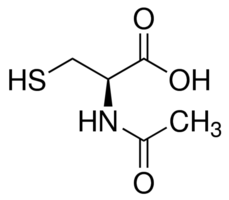N-Acetyl-L-cysteine CAS#: 616-91-1; ChemWhat Code: 82555
Identification
| Patent ID | Title | Publication Date |
| US6759061 | Liver function improvement formulation | 2004 |
| US2010/239552 | Combination Therapies for Treating Metabolic Disorders | 2010 |
| WO2018/203194 | DIAZABICYCLOOCTANE DERIVATIVES COMPRISING A QUATERNERY AMMONIUM GROUP FOR USE AS ANTIBACTERIAL AGENTS | 2018 |
Physical Data
| Appearance | White crystals or crystalline powder |
| Solubility | H2O: 100 mg/mL with heating |
| Flash Point | No data available |
| Refractive index | No data available |
| Sensitivity | No data available |
| Melting Point, °C | Solvent (Melting Point) |
| 106 – 108 | |
| 93 – 104 | |
| 127 – 129 | propan-2-ol |
| 128.7 – 129.4 | ethanol |
| 107 – 107.5 | propan-2-ol, diethyl ether |
| Partition Constant POW | Temperature (Association (MCS)), °C |
| 0.3 | 37 |
Spectra
| Description (NMR Spectroscopy) | Nucleus (NMR Spectroscopy) | Solvents (NMR Spectroscopy) | Frequency (NMR Spectroscopy), MHz |
| Spectrum | 1H | d(4)-methanol | 400 |
| Spectrum | 1H | water-d2 | 500 |
| Spectrum | 1H | dimethylsulfoxide-d6 | |
| NMR |
| Description (IR Spectroscopy) | Comment (IR Spectroscopy) |
| Spectrum | 2500 – 1100 cm**(-1) |
| IR |
| Description (UV/VIS Spectroscopy) |
| Absorption maxima |
Route of Synthesis (ROS)
| Conditions | Yield |
| With ammonia In methanol at 60℃; for 5h; Amberlite IRA400(CI); Experimental Procedure Cyanomethyl-carbamic acid tert-butyl ester (10 grains, 64.02 mmol) and 2- acetylamino-3-mercapto-propionic acid (10.45 grams, 64.02 mmol) were dissolved in 7N ammonia in methanol (140 ml) and heated at 60 0C in a sealed glass bomb for 5 hours. The reaction was cooled to ambient temperature, the solvent removed and the residue dissolved in water (250 ml). The aqueous layer was washed with ether and then loaded onto an ion exchange column (Amberlite IRA-400C1) charged with saturated ammonium chloride, eluting with water. The pure fractions were combined and lyophilized to yield Compound 18.1 (11.30 grams, 53.89 rnrnol, 84%). ES (+) MS m/e = 174 (M+l). | 84% |
Safety and Hazards
| Pictogram(s) |  |
| Signal | Warning |
| GHS Hazard Statements | H315 (62.96%): Causes skin irritation [Warning Skin corrosion/irritation] H319 (96.3%): Causes serious eye irritation [Warning Serious eye damage/eye irritation] H335 (59.26%): May cause respiratory irritation [Warning Specific target organ toxicity, single exposure; Respiratory tract irritation] Information may vary between notifications depending on impurities, additives, and other factors. |
| Precautionary Statement Codes | P261, P264, P271, P280, P302+P352, P304+P340, P305+P351+P338, P312, P321, P332+P313, P337+P313, P362, P403+P233, P405, and P501 (The corresponding statement to each P-code can be found at the GHS Classification page.) |
Other Data
| Transportation | NONH for all modes of transport |
| Under the room temperature and away from light | |
| HS Code | 29309016 |
| Storage | Under the room temperature and away from light |
| Shelf Life | 2 years |
| Market Price | USD |
| Druglikeness | |
| Lipinski rules component | |
| Molecular Weight | 163.197 |
| logP | -0.133 |
| HBA | 4 |
| HBD | 2 |
| Matching Lipinski Rules | 4 |
| Veber rules component | |
| Polar Surface Area (PSA) | 105.2 |
| Rotatable Bond (RotB) | 4 |
| Matching Veber Rules | 2 |
| Use Pattern |
| N-Acetyl-L-cysteine CAS#: 616-91-1 is used as a sputum dissolving agent |
| N-Acetyl-L-cysteine CAS#: 616-91-1 an antidote for acetaminophen, arsenic and mercury poisoning. |
| N-Acetyl-L-cysteine CAS#: 616-91-1 can also protect the liver against the toxic effects of alcohol and reduce the toxic side effects of cancer drugs. |
Buy Reagent | |
| No reagent supplier? | Send quick inquiry to ChemWhat |
| Want to be listed here as a reagent supplier? (Paid service) | Click here to contact ChemWhat |
Approved Manufacturers | |
| Apnoke Scientific Ltd | http://www.apnoke.com/ |
| Want to be listed as an approved manufacturer (Requires approvement)? | Please download and fill out this form and send back to approved-manufacturers@chemwhat.com |
Contact Us for Other Help | |
| Contact us for other information or services | Click here to contact ChemWhat |


